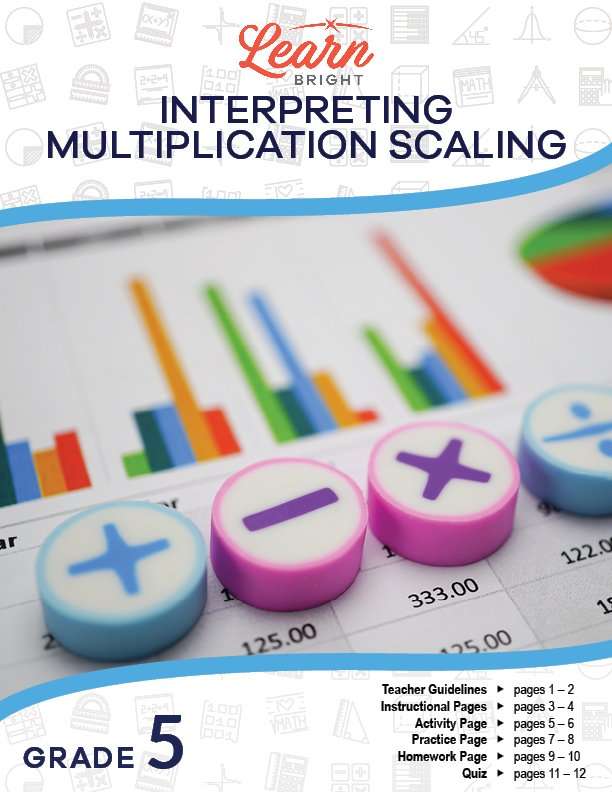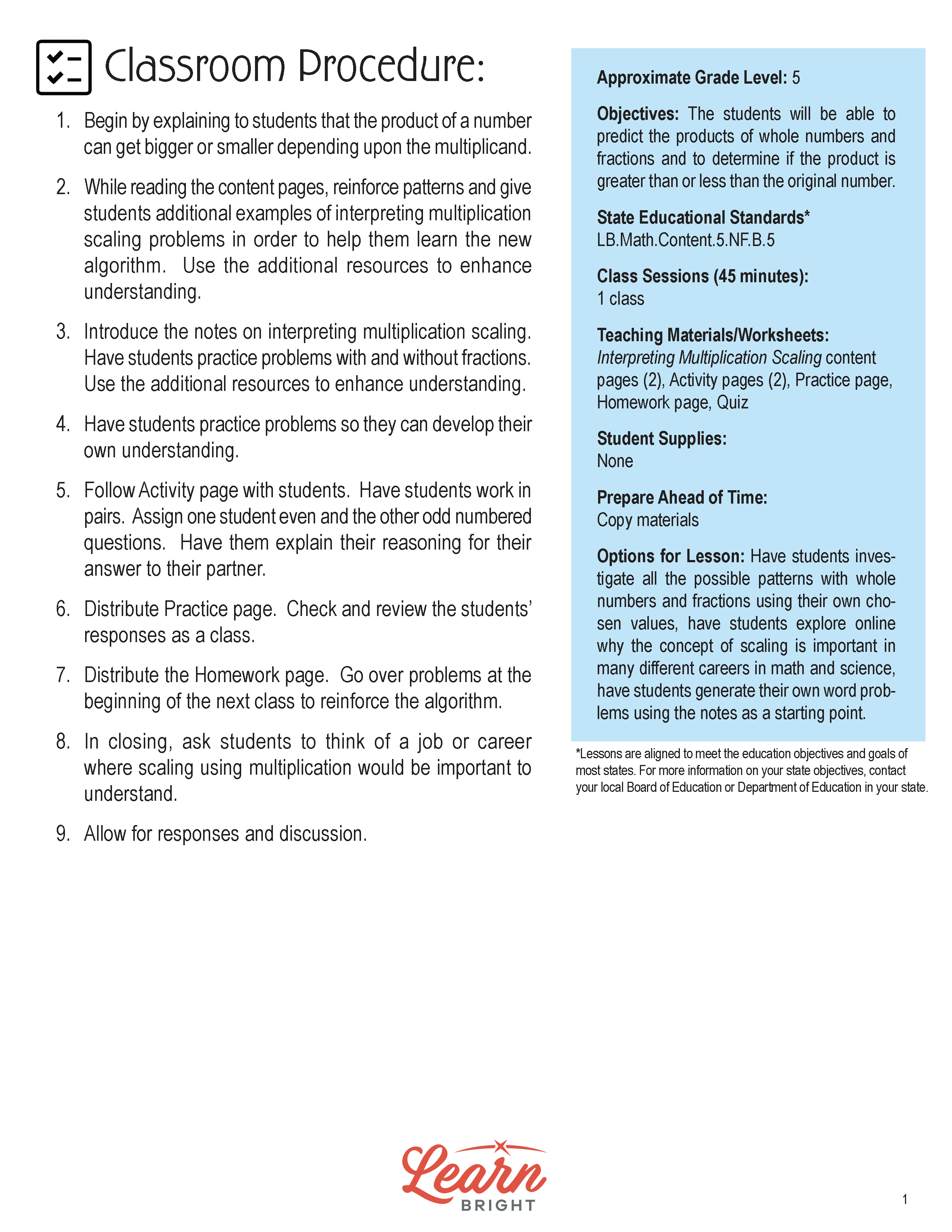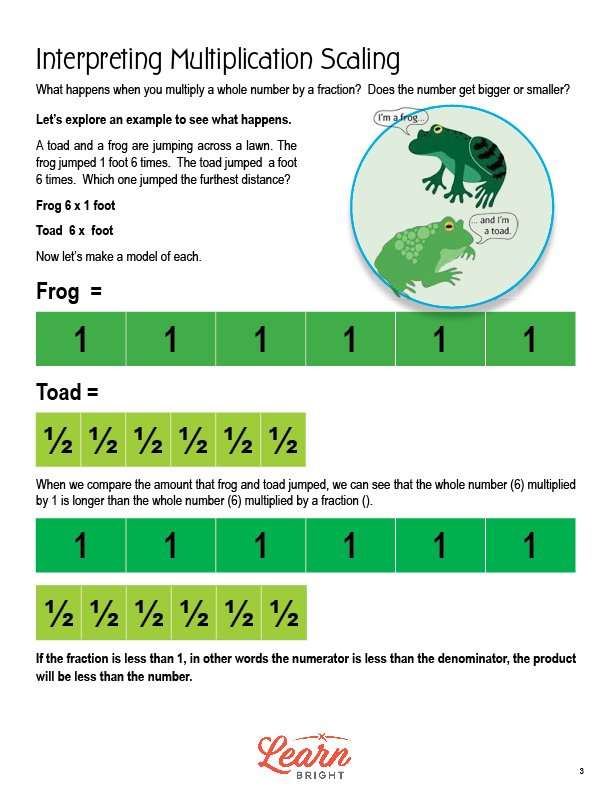Description
What our Interpreting Multiplication Scaling lesson plan includes
Lesson Objectives and Overview: Interpreting Multiplication Scaling teaches students to predict the products of whole numbers and fractions and determine if the product is greater than or less than the original number. This lesson is for students in 5th grade.
Classroom Procedure
Every lesson plan provides you with a classroom procedure page that outlines a step-by-step guide to follow. You do not have to follow the guide exactly. The guide helps you organize the lesson and details when to hand out worksheets. It also lists information in the blue box that you might find useful. You will find the lesson objectives, state standards, and number of class sessions the lesson should take to complete in this area. In addition, it describes the supplies you will need as well as what and how you need to prepare beforehand.
Options for Lesson
Included with this lesson is an “Options for Lesson” section that lists a number of suggestions for activities to add to the lesson or substitutions for the ones already in the lesson. One optional addition to this lesson is to have students investigate all possible patterns with whole numbers and fractions using their chosen values. You can also have students use the internet to explore why the concept of scaling is important in math and science. Finally, you could have students create their own word problems using the notes as a starting place.
Teacher Notes
The teacher notes page includes lines that you can use to add your own notes as you’re preparing for this lesson.
INTERPRETING MULTIPLICATION SCALING LESSON PLAN CONTENT PAGES
Interpreting Multiplication Scaling
The Interpreting Multiplication Scaling lesson plan includes two content pages. The lesson begins by asking what happens when you multiply a whole number by a fraction. It explores the answer to this question using an example problem in which a frog jumps 1 foot 6 times and a toad jumps 1 foot 6 times. We need to figure out the distance of each by making models, shown on the content pages.
Using these models, we can figure out that the whole number multiplied by 1 is longer than the whole number multiplied by a fraction. If the fraction is less than one (the numerator is less than the denominator), the product will be less than the number.
Next, we need to explore what happens when you multiply a whole number by a number greater than 1 (a whole number or an improper fraction). The lesson uses another example to explore this question.
Using models, we can determine that if the fraction is greater than 1 (the numerator is greater than the denominator), the product will be greater than the number. If the fraction is equal to 1 (the numerator is equal to the denominator), the product will equal the number.
If you multiply any number by another number that is larger than zero but less than one, your answer will always be smaller. Finally, if you multiply any number by another number that is larger than one, your answer will always be bigger.
INTERPRETING MULTIPLICATION SCALING LESSON PLAN WORKSHEETS
The Interpreting Multiplication Scaling lesson plan includes four worksheets: an activity worksheet, a practice worksheet, a homework assignment, and a quiz. You can refer to the guide on the classroom procedure page to determine when to hand out each worksheet.
WHICH IS BIGGER ACTIVITY WORKSHEET
For the activity worksheet, students will decide which number is bigger without multiplying in eight sets of numbers.
FILL IN THE CHART PRACTICE WORKSHEET
The practice worksheet asks students to fill in the charts on the worksheet. Each chart requires them to determine whether multiplying by the given number means the result will be smaller or larger and product when the given number is multiplied by 1, 2, 4, 6, and 8.
INTERPRETING MULTIPLICATION SCALING HOMEWORK ASSIGNMENT
For the homework assignment, students will read a word problem and answer two questions about it.
QUIZ
This lesson includes a quiz that you can use to test students’ understanding of the lesson material. For this quiz, students will fill in the blanks using words from a word bank.
Worksheet Answer Keys
This lesson plan includes answer keys for the activity worksheet, the practice worksheet, the homework assignment, and the quiz. If you choose to administer the lesson pages to your students via PDF, you will need to save a new file that omits these pages. Otherwise, you can simply print out the applicable pages and keep these as reference for yourself when grading assignments.









